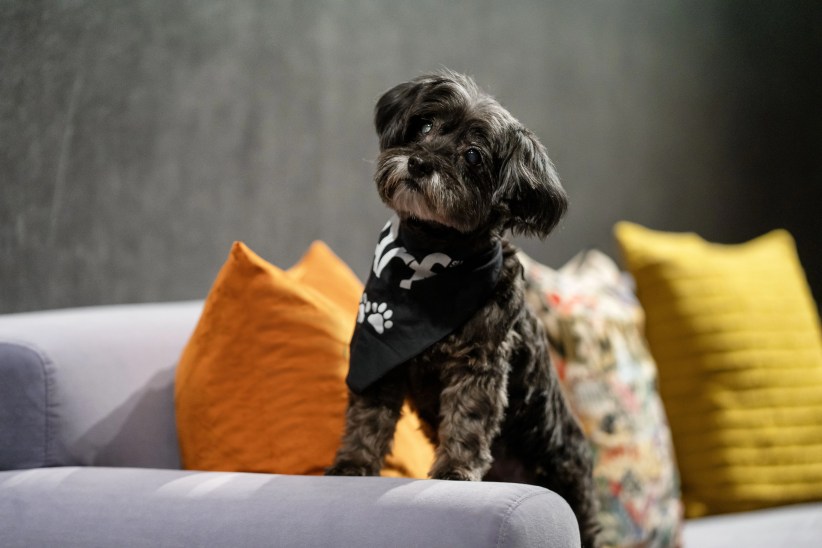Our pets are part of our family and we want to ensure that they are comfortable and happy, and healthy at all times (after all, they help keep us healthy). Earlier this week, a passenger’s dog was stored inside an overhead bin on United Airlines Flight 1284 for more than three hours and tragically passed away, according to cnn.com. Here are some of the best practices to maintain when traveling with a pet, according to Dr. Danielle Bernal, D.V.M., veterinarian with Wellness Natural Pet Food.
Get the facts before you fly.
While every airline has its own guidelines and policies, pets that you should avoid bringing on a flight altogether are brachycephalic dogs–in other words dogs with shortened heads. Breeds such as pugs, chow chows, Chihuahuas, and English bulldogs have more respiratory issues due to their squished-in faces, and the high altitudes of an airplane can make it particularly difficult for them to breathe. If your dog tends to snore, he might have difficulty breathing and it may be dangerous for him to fly, according to Dr. Bernal.
Help your pet prepare.
The best way to prepare a pet emotionally for a trip is to ease her into the idea of it. Introduce your pet to the environment of a car and to the sound of the engine, similarly to the way you would introduce your pet to a new baby. You can start by driving your pet around the block.and then gradually work your way toward longer distances.
“There’s a stage of excitement,” said Dr. Bernal. “Pets will respond to everything they are seeing for the first time and most dogs are happier about going on trips than you would think.”
Put together a packing list.
Most dogs and cats don’t need food while traveling, but they should have a steady supply of water throughout the trip. Some carriers have attachable water bowls that are easily accessible for pets but won’t tip over and make a mess. For long car rides, snacks and treats are a good way to keep your pet happy, especially if taking bathroom breaks along the route.
Properly restrain your pet.
Your pet should never be completely free to roam around if she is in a car or on an airplane. If you are going on a long car ride, pets should be confined but in an area that is safe and comfortable. If your dog is traveling in a carrier, hard crates are recommended because they cannot become squashed and hurt the animal. When choosing a carrier, it is important to ensure that your pet can not only stand up in it but also can turn around.
“The soft carrier that may look cool and trendy is not necessarily catered for easy ventilation,” said Dr. Bernal. “It only takes seven minutes for a pet to overheat and pass away, so air flow is crucial.”
For bigger pets that may not comfortably fit in a crate, Dr. Bernal recommends special harnesses that go into car seatbelts in order to keep the pet stationary but comfortable.
Think before you sedate.
A lot of people think that in order to travel with a pet, you need to sedate him/her in order to relieve anxiety and stress. While there are pets that suffer from panic, car sickness, seizures, and other conditions that may cause restlessness during a trip, dogs and cats are generally more resilient than we realize. Generally, Dr. Bernal does not recommend sedating a pet unless it is absolutely necessary, as it can interfere with some of the key mechanisms that a pet needs to react to certain scenarios. The pet’s ability to adjust to changing conditions and react to a possible emergency can be hindered by sedation and, unless there is something strategically wrong with the pet, it is best to stay away from forms of sedation. Your pet will be able to adapt and handle the changing situations, but continuously check to make sure she is okay.
Speak up for your pet.
When traveling with a pet, you are primarily responsible for his happiness and safety. Don’t be afraid to ask the flight crew any and all questions about what practices are okay, if there will be enough room at your seat for your pet, if you can take your pet out to comfort him etc. Various airports have green space outside of the terminals that you can utilize to walk your pet around, take him to use the bathroom, or just to give him some fresh air. Exercise the rights you have as a passenger to protect your pet because he is a passenger as well.
“Raise any and all pet concerns when you are on a flight,” said Dr. Bernal. “Ask for water, ask for a cold cloth if necessary, and be responsible for your pet and respectful of those around you on the flight who may not be comfortable around your pet.”






















